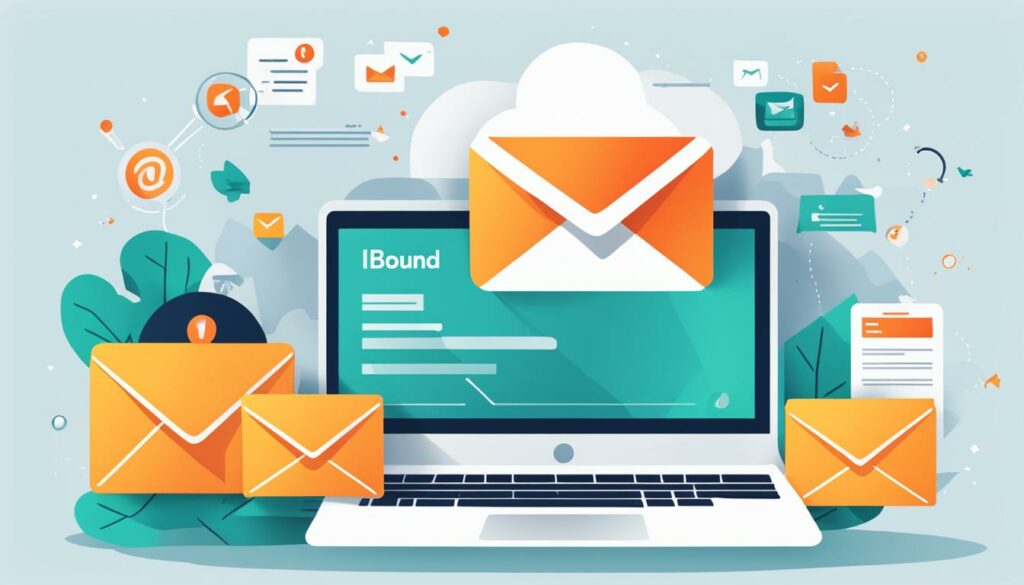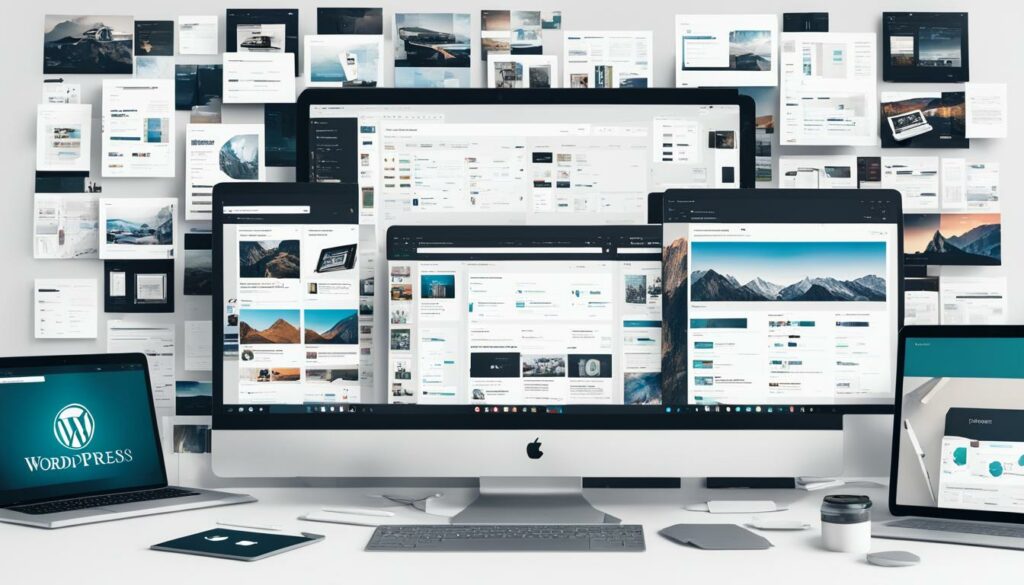Are you looking to boost the performance of your email campaigns? Want to engage your audience and achieve better results? Look no further. In this article, we will explore the best practices for email marketing that will help you optimize your campaigns, increase engagement, and drive success.
Email marketing has proven to be an effective strategy for reaching business goals, with 94% of marketers finding it effective, according to a HubSpot survey. But to get the most out of your email marketing efforts, you need to follow the right strategies and techniques.
In this comprehensive guide, we will cover a wide range of topics, including optimizing your email delivery, personalizing your emails, implementing AI in your campaigns, and much more. By following these best practices, you will be able to create engaging campaigns that resonate with your audience and deliver the results you desire.
Key Takeaways:
- Implement best practices to optimize your email campaigns and improve performance.
- Engage your audience by personalizing your emails and using targeted strategies.
- Utilize AI technology to automate processes, improve targeting, and optimize campaign performance.
- Regularly analyze and optimize your campaigns based on key metrics and insights.
- Ensure email deliverability and compliance to maintain a strong reputation and boost engagement.
Email Marketing Best Practices
Implementing best practices in your email marketing strategy will ensure that you are maximizing results and reaching your goals. By following these practices, you can improve deliverability, engagement, and overall performance of your email campaigns.
1. Avoid Purchasing Contact Lists
Purchasing contact lists may seem like a quick way to expand your audience, but it can harm your email marketing efforts. These lists often contain outdated or incorrect information, resulting in low engagement and high bounce rates. Instead, focus on organically growing your email list through opt-ins and other legitimate methods.
2. Say No to “No-Reply”
Using a “No-Reply” email address as the sender can create a disconnect between you and your subscribers. It prevents two-way communication and discourages engagement. Instead, use a personalized email address that encourages recipients to reply and interact with your emails.
3. Optimize Email Preview Text
The preview text is the snippet of text that appears below the subject line in email clients. It gives recipients a glimpse of what your email is about. By optimizing your preview text with a compelling and concise message, you can increase open rates and encourage recipients to engage with your email.
4. Include an Email Signature
Adding an email signature to your emails adds a personal touch and enhances professionalism. It allows recipients to easily identify your brand and contact information. Keep the signature brief and relevant, including your name, title, company, and contact details.
5. Clean Your Mailing List Regularly
Regularly cleaning your mailing list is essential for maintaining a healthy and engaged audience. Remove inactive subscribers, correct bounced email addresses, and update any necessary information. This practice helps improve deliverability rates and ensures that your messages reach the right audience.
To summarize, implementing email marketing best practices, such as avoiding purchased contact lists, using personalized email addresses, optimizing preview text, including an email signature, and regularly cleaning your mailing list, will enhance the effectiveness of your campaigns and drive better results.
Outbound Email Best Practices
When it comes to sending outbound emails, it’s crucial to follow best practices that ensure your messages are effective and engaging. By implementing the following key practices, you can capture your audience’s attention and increase the likelihood of engagement with your email campaigns.
- Personalize the email greeting: Addressing recipients by their names adds a personal touch to your emails, making them feel more relevant and tailored to their needs.
- Keep emails brief and easy to skim: People receive numerous emails every day, so it’s important to convey your message concisely. Use clear headings, bullet points, or numbered lists to make your content easy to scan.
- Perfect the subject line and preview text: The subject line and preview text are the first things recipients see, so make sure they are compelling and enticing. Use language that grabs attention and encourages opening the email.
- Include a compelling call-to-action: Every email should have a clear and specific call-to-action that prompts recipients to take the desired action, such as making a purchase, signing up for a webinar, or downloading a resource. Ensure that your call-to-action stands out and is easy to follow.
To visualize the impact of implementing outbound email best practices, consider the following data:
| Best Practice | Effect on Engagement |
|---|---|
| Personalized Greeting | Increased open rates |
| Brief and Skimmable Emails | Higher click-through rates |
| Compelling Subject Line and Preview Text | Improved email open rates |
| Compelling Call-to-Action | Higher conversion rates |
By incorporating these outbound email best practices into your campaigns, you can optimize the effectiveness of your outreach and increase engagement with your target audience.
Inbound Email Marketing Best Practices
When it comes to email marketing, building strong and meaningful relationships with your subscribers is key. Implementing inbound email marketing best practices will help you create a connection with your audience and drive engagement with your email campaigns. Here are some tips to get you started:
- Use double opt-in email sign-up: Implementing a double opt-in process ensures that only interested and engaged subscribers join your email list. This helps you build a high-quality email list and avoid spam complaints.
- Send a welcome email: Make a great first impression by sending a welcome email to new subscribers. This email allows you to introduce your brand, set expectations, and deliver any welcome offers or incentives.
- Avoid using a “no-reply” email address: Use a sender’s email address that shows your subscribers that you’re open to communication. Using a “no-reply” email address can give the impression that you’re uninterested in hearing from your audience.
- Personalize your emails: Make each email feel personal by addressing subscribers by their name and tailoring the content based on their preferences or past interactions. Personalization makes your subscribers feel valued and increases engagement.
- Write in a casual and conversational tone: Avoid a formal tone in your emails. Instead, write in a casual and conversational style that resonates with your audience. This helps create a more human connection and fosters engagement.
“Implementing inbound email marketing best practices will help you create a connection with your audience and drive engagement with your email campaigns.”
By implementing these inbound email marketing best practices, you can position your brand as a trusted resource, nurture relationships with your subscribers, and drive engagement with your email campaigns. Remember, building a meaningful connection with your audience is a continuous process that requires ongoing optimization and personalization.
To illustrate the impact of personalized emails, here’s a comparison table showcasing the engagement rates of personalized vs. non-personalized emails:
| Email Type | Open Rate | Click-Through Rate |
|---|---|---|
| Personalized Emails | 32% | 7% |
| Non-Personalized Emails | 18% | 3% |
As you can see from the table, personalizing your emails can significantly boost both open rates and click-through rates, indicating a higher level of engagement from your subscribers.

In the next section, we’ll explore the use of AI in email marketing and how it can enhance your campaigns to deliver even better results.
Using AI in Email Marketing
The use of AI in email marketing can greatly enhance your campaigns and improve your results. AI technology offers a range of capabilities that can automate processes, optimize targeting and personalization, and enhance the overall performance of your email marketing campaigns.
Writing and Optimizing Emails
One of the key advantages of AI in email marketing is its ability to assist with writing and optimizing your emails. AI-powered tools can analyze vast amounts of data and use natural language processing algorithms to generate compelling email content. This can save you time and effort while ensuring that your emails are engaging and relevant to your audience.
Determining the Best Time to Send Emails
Poor timing can greatly impact the effectiveness of your email campaigns. AI can help you determine the best time to send your emails by analyzing data on your subscribers’ behavior, such as open rates and click-through rates at different times of the day. By identifying the optimal sending times, you can improve the chances of your emails being opened and read.
Personalizing Emails
Personalization is key to engaging your audience and increasing the effectiveness of your email campaigns. AI technology can help you personalize your emails by segmenting your audience based on their preferences, demographics, or past behavior. By sending targeted and personalized emails, you can deliver content that resonates with your subscribers and encourages them to take action.
Analyzing Customer Behavior
Understanding your customers’ behaviors and preferences is crucial to optimizing your email marketing strategy. AI can analyze data on customer interactions, such as email opens, clicks, and conversions, to provide valuable insights. These insights can help you identify patterns, segment your audience effectively, and tailor your emails to meet their needs and expectations.
“AI technology offers a range of capabilities that can automate processes, optimize targeting and personalization, and enhance the overall performance of your email marketing campaigns.”
By leveraging AI in your email marketing strategy, you can unlock new possibilities and drive better results. From writing and optimizing emails to personalization and analyzing customer behavior, AI technology can revolutionize the way you engage with your audience and achieve your email marketing goals.
Benefits of AI in Email Marketing
| Benefits | Description |
|---|---|
| Automated Processes | AI can automate time-consuming tasks such as email content generation and optimization, saving you time and improving productivity. |
| Improved Targeting | By analyzing customer data, AI can help you segment your audience effectively and deliver personalized content that resonates with each segment. |
| Enhanced Personalization | AI technology can personalize emails based on individual preferences and behaviors, leading to higher engagement and conversion rates. |
| Optimized Performance | With AI’s ability to analyze customer behavior, you can gain valuable insights and optimize your email campaigns for better results. |
Time and Frequency of Sending Emails
The timing and frequency of sending emails play a crucial role in the success of your email campaigns. By strategically scheduling your emails and finding the right balance, you can engage your audience and maximize the impact of your email marketing efforts.
When it comes to timing, you want to send your emails at a time when your audience is most likely to be engaged and receptive. This requires understanding your target audience and their behavior. Consider factors such as their geographic location, industry, and lifestyle to determine the optimal sending times.
Testing different sending times can provide valuable insights into when your subscribers are most active. Use email marketing software that offers A/B testing capabilities to send emails at different times and analyze the results. This data-driven approach will help you identify patterns and determine the best time for maximum engagement.
Once you’ve determined the optimal timing for your email campaigns, it’s important to find the right balance in frequency. Sending too many emails can overwhelm your subscribers and lead to higher unsubscribe rates. On the other hand, sending too few emails may result in your audience forgetting about your brand.
It’s recommended to establish a regular schedule for sending emails, such as weekly newsletters or monthly updates. Consistency builds trust and keeps your brand top-of-mind. However, be mindful not to sacrifice quality for quantity. Ensure that each email provides value and delivers relevant and engaging content to your subscribers.
As your email list grows and your audience evolves, don’t hesitate to refine your email timing and frequency. Regularly analyze the performance of your campaigns and monitor engagement metrics, such as open rates and click-through rates. By continuously optimizing the timing and frequency of your email sends, you can enhance the effectiveness of your campaigns and drive better results.
Building and Growing Your Email List
Building and growing your email list is a critical component of your email marketing strategy. By expanding your subscriber base, you can effectively reach a larger audience and increase the performance of your email campaigns. Here are some proven strategies to help you build and grow your email list:
- Opt-in forms: Place opt-in forms strategically on your website to capture visitors’ email addresses. Consider adding forms to your homepage, blog sidebar, and landing pages to maximize visibility and conversions.
- Incentives for sign-ups: Offer exclusive incentives such as free e-books, discount codes, or access to valuable content in exchange for email sign-ups. This provides an extra incentive for visitors to subscribe to your list.
- Pop-up forms: Utilize pop-up forms to capture the attention of your website visitors and encourage them to join your email list. Make sure the timing and design of the pop-up are user-friendly and unobtrusive.
- Contact imports: Import contacts from other sources, such as customer databases or social media platforms. Leverage your existing network to jump-start your email list growth.
By implementing these strategies and continuously optimizing your sign-up process, you can steadily grow your email list, extend your reach, and engage a wider audience.
Pro Tip: Remember to always provide value to your subscribers. People are more likely to sign up and stay engaged if they perceive your emails as valuable and relevant to their needs.
Email List Growth Success Story
One success story in email list growth comes from XYZ Company. They wanted to expand their reach and improve their email campaign performance. By implementing a comprehensive list building strategy, they were able to triple their subscriber base within six months. Some key tactics they used included:
- Creating a visually appealing and user-friendly pop-up form that offered a 10% discount for first-time subscribers.
- Using compelling call-to-action buttons with clear messaging to encourage sign-ups.
- Collaborating with influencers in their industry to promote their email newsletter and reach a wider audience.
- Regularly refining their opt-in forms based on A/B testing and analyzing user behavior.
By consistently applying these strategies and staying attuned to their audience’s needs, XYZ Company experienced significant growth in their email list, resulting in improved engagement and higher conversions for their email marketing campaigns.

Email Segmentation and Personalization
Segmenting your email list and personalizing your emails are essential strategies to improve engagement and boost the performance of your email campaigns. By categorizing your subscribers based on specific criteria, such as demographics or past behavior, you can deliver tailored content that resonates with their interests and needs.
When it comes to email segmentation, consider factors such as age, location, purchase history, or engagement level. By understanding your subscribers’ preferences and behaviors, you can send targeted emails that are more likely to capture their attention and drive action.
Personalization takes segmentation a step further by customizing individual emails to create a more personalized experience. This can include using the subscriber’s name, recommending products based on their past purchases, or sending targeted offers that align with their interests.
Research has shown that personalized emails have higher open rates, click-through rates, and conversion rates. By making your subscribers feel like you know them and are addressing their specific needs, you can establish trust and build stronger relationships.
Here’s an example of how effective email segmentation and personalization can be:
| Segment | Open Rate | Click-Through Rate |
|---|---|---|
| New Subscribers | 40% | 10% |
| Active Subscribers | 60% | 15% |
| Past Customers | 70% | 20% |
In this example, the email campaign was segmented based on subscriber types: new subscribers, active subscribers, and past customers. By tailoring the content to each segment’s specific needs and preferences, the open rates and click-through rates increase significantly, resulting in a more engaged and responsive audience.
Remember, successful email marketing is all about delivering relevant content that resonates with your audience. By implementing email segmentation and personalization strategies, you can increase the effectiveness of your campaigns, improve engagement, and ultimately drive better results.
Email Deliverability and Compliance
Ensuring email deliverability and compliance is crucial for the success of your email marketing efforts. By following best practices in email deliverability and compliance, you can improve the chances of your emails reaching your subscribers’ inboxes and avoid potential legal issues. Here are some key practices to consider:
- Set up opt-ins and double opt-ins: Implementing opt-in processes ensures that your subscribers have explicitly given consent to receive your emails. Double opt-ins add an extra layer of verification, confirming subscribers’ intent and minimizing the risk of spam complaints.
- Use valid email addresses: Instead of using a “no-reply” email address, consider using a valid address that allows recipients to reply and engage with you. This encourages two-way communication and strengthens your relationship with subscribers.
- Regularly clean your contact list: Removing inactive or disengaged subscribers from your email list helps maintain a healthy sender reputation and improves email deliverability. It also ensures that you are reaching an audience genuinely interested in your content.
Email Analytics and Optimization
Monitoring and analyzing the performance of your email campaigns is crucial for optimizing and improving their effectiveness. By tracking key metrics such as open rates, click-through rates, and conversion rates, you can gain valuable insights into your campaign’s performance and identify areas for improvement.
Experimenting with various elements, such as subject lines, calls-to-action (CTAs), and email content, can help you identify what resonates best with your audience. A/B testing different variations allows you to compare the performance of different elements and make data-driven decisions to optimize your email campaigns.
Here are some essential metrics to monitor:
- Open rates: Measure the percentage of recipients who open your emails to gauge the effectiveness of your subject lines and sender name.
- Click-through rates (CTR): Evaluate the percentage of recipients who click on links within your emails to assess the engagement and relevance of your content.
- Conversion rates: Track the percentage of recipients who complete a desired action, such as making a purchase or filling out a form, to measure the overall effectiveness of your email campaigns.
- Bounce rates: Monitor the percentage of emails that are undeliverable. High bounce rates may indicate issues with your email list quality or content.
- Unsubscribe rates: Measure the percentage of recipients who unsubscribe from your emails to gauge the relevance and value of your content.
Email Optimization Techniques
Once you’ve analyzed your email campaign metrics, you can take steps to optimize your emails and improve your campaign’s performance. Here are some techniques to consider:
- Subject line optimization: Craft compelling subject lines that grab attention and entice recipients to open your emails.
- Personalization: Tailor your emails to individual recipients by including their name or personal details, ensuring a more personalized and engaging experience.
- CTA optimization: Experiment with different CTAs and placements to encourage recipients to take the desired action.
- Email content optimization: Test different email content formats, lengths, and designs to determine what resonates best with your audience.
To further enhance your email optimization efforts, consider leveraging AI technology. AI-powered tools can provide valuable insights, automate processes, and help you deliver more targeted and personalized email campaigns.
| Optimization Technique | Description |
|---|---|
| Subject Line Optimization | Experiment with different subject lines to increase open rates and engagement. |
| Personalization | Deliver personalized content based on recipient data for a more tailored experience. |
| CTA Optimization | Test different CTAs and placements to improve click-through rates and conversions. |
| Email Content Optimization | Improve email content format, length, and design for better engagement and readability. |
To effectively optimize your email campaigns, it’s essential to regularly review and analyze your results, implement changes based on insights gained, and continue testing and refining your approach. This iterative process will lead to continuous improvement and increased performance of your email campaigns.
Conclusion
Implementing email marketing best practices is crucial for creating engaging campaigns and achieving successful email marketing strategies. By following these practices, such as personalizing your emails, optimizing email delivery, and analyzing campaign performance, you can enhance your email marketing strategy and effectively connect with your audience.
Personalization plays a vital role in engaging your recipients. By tailoring your emails to their interests and needs, you can deliver more relevant content and foster stronger connections. Additionally, optimizing email delivery ensures that your emails reach the intended recipients’ inboxes, increasing the chances of engagement.
Regularly reviewing and analyzing campaign performance is essential for continuous improvement. Monitoring key metrics like open rates, click-through rates, and conversions allows you to identify what is working well and what needs adjustment. By staying informed about the latest trends and experimenting with different elements, you can optimize your email campaigns and maximize their effectiveness.
FAQ
What are some email marketing best practices?
Some email marketing best practices include not purchasing contact lists, avoiding “No-Reply” in sender’s email address, optimizing email preview text, including an email signature, and cleaning your mailing list regularly.
How can I make my outbound emails more effective?
To make your outbound emails more effective, consider personalizing the email greeting, keeping emails brief and easy to skim, perfecting the subject line and preview text, and including a compelling call-to-action.
What are the best practices for inbound email marketing?
Best practices for inbound email marketing include using double opt-in email sign-up, sending a welcome email, avoiding the use of a “no-reply” email address, personalizing your emails, and writing in a casual and conversational tone.
How can AI enhance my email marketing campaigns?
AI can enhance your email marketing campaigns by assisting with tasks such as writing and optimizing emails, determining the best time to send emails, personalizing emails, and analyzing customer behavior.
How important is the timing and frequency of sending emails?
The timing and frequency of sending emails can significantly impact the success of your campaigns. It is important to schedule your emails at times when your audience is most likely to be engaged and receptive, while finding the right balance in frequency.
What are some effective strategies for building and growing an email list?
Some effective strategies for building and growing your email list include using opt-in forms on your website, offering incentives for sign-ups, using pop-up forms, and importing contacts from other sources.
How can email segmentation and personalization improve engagement?
Email segmentation and personalization improve engagement by allowing you to tailor your emails to specific groups of subscribers based on criteria such as demographics or past behavior, delivering more relevant content.
What should I do to ensure email deliverability and compliance?
To ensure email deliverability and compliance, it is important to set up opt-ins and double opt-ins, use valid email addresses instead of “no-reply,” regularly clean your contact list, and comply with anti-spam regulations such as GDPR.
How can I monitor and optimize the performance of my email campaigns?
You can monitor and optimize the performance of your email campaigns by tracking key metrics such as open rates, click-through rates, and conversion rates, experimenting with different elements, and conducting A/B testing.
What are some email marketing best practices for engaging campaigns?
Some email marketing best practices for engaging campaigns include personalizing emails, optimizing email delivery, and analyzing performance to continuously evaluate and optimize your campaigns.












